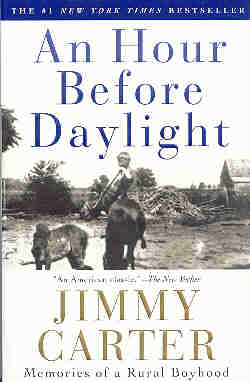An Hour Before Daylight
Jimmy Carter

“Although Plains was less than three miles away, life there was quite different from the time I spent on our farm in Archery. My first acquaintance with the town's social life came through my grandmother Nina Carter, who lived alone in the same house our family had bought when they first moved here from South Georgia in 1904. She insisted on having company every night, so her various grandchildren were assigned this rotating duty. My day was Friday, and this weekly visit gave me a chance to become better acquainted with some of my town schoolmates and to play hide-and-seek, tin can, and marbles, and have rubber-gun wars with the neighborhood children. When I approached my teenage years, I began to go to prom parties sponsored by the town churches. After one of Mama Carter's neighbors, Eloise Ratliff, became my first sweetheart, I was eager to take my turn at visiting her.”
The paragraph above comes from former President Jimmy Carter's autobiography, An Hour Before Daylight. Subtitled “Memories of a Rural Boyhood,” it's filled with stories of a time that seems far removed from the current day, and particularly from the years that the Carters occupied the White House. The next passage reads:
“To me, Mama Carter personified urban gentility, an affectation that she was committed to maintain. She was vain about her natural beauty, and concealed with ferocity any information about her age. Although there was always brandy in her cupboard, her favorite drink, at least in the presence of us grandchildren, was sassafras tea. As a farm boy, I had the duty of keeping her supplied with the dried aromatic roots, which had the flavor of root beer and, she believed, great medicinal value. She did her own cooking and housekeeping, but we were expected to cut and bring in stove wood for the kitchen and coal for the living room fireplace, and to empty the two chamber pots every morning. Compared with those in out house, they were extraordinarily large and beautifully decorated, and she was especially proud of them. Unlike most other people, she didn't hide them under the bed during the daytime.
My grandmother had been born and raised near Greenwood, South Carolina, at a place on the railroad that was marked with her family name, Pratt. On a few occasions, my parents would take my grandmother and me and drop us off to visit with her family while they went on up north to see major-league baseball games. Even measured by Plains and Archery standards, this was an isolated, delicate, and ancient culture, since the Pratt women (all either widows or spinsters) seemed to have an aversion to changing anything around the family homestead. They were still carding wool and cotton, using a spinning wheel to make thread, weaving cloth, and churning butter in a small barrel mounted off-center on a turning shaft. They didn't have electricity, a radio, or even Aladdin lamps, depending entirely on candles and a few kerosene lamps in rooms that were always darkened by pulled shades to prevent fading of the furniture coverings; they went to bed every evening, even in winter, while there was still daylight outside.”
Recreating his Depression-era boyhood on a Georgia farm before the civil rights movement changed it and the country forever, Jimmy Carter's prose evokes a time when the cycles of life were simple and predictable and the rules were heartbreaking and complex. More than just a memoir, An Hour Before Daylight is both a social history and a portrait of a time gone beyond recall. Be sure to read all about it.
All Rights Reserved.